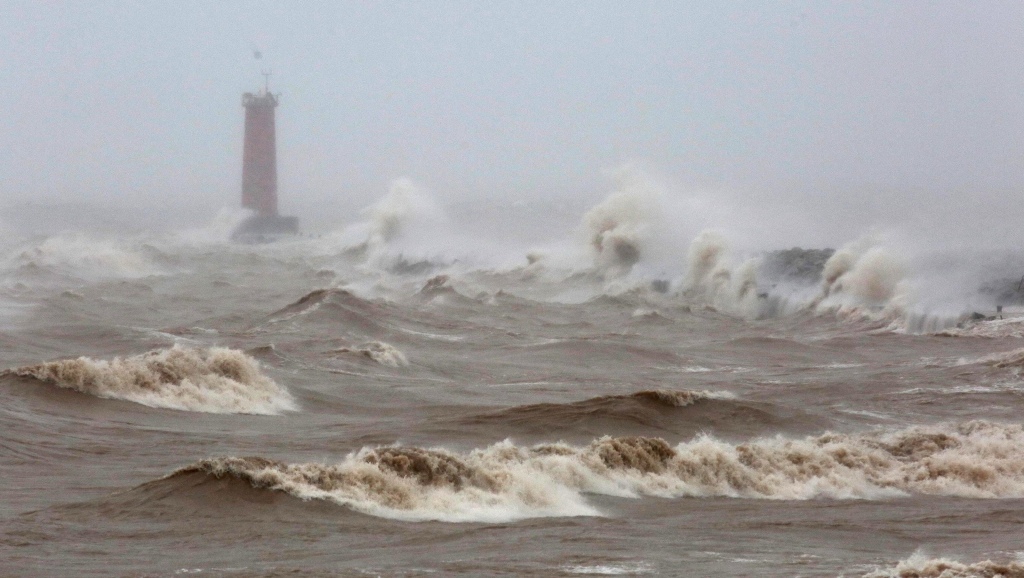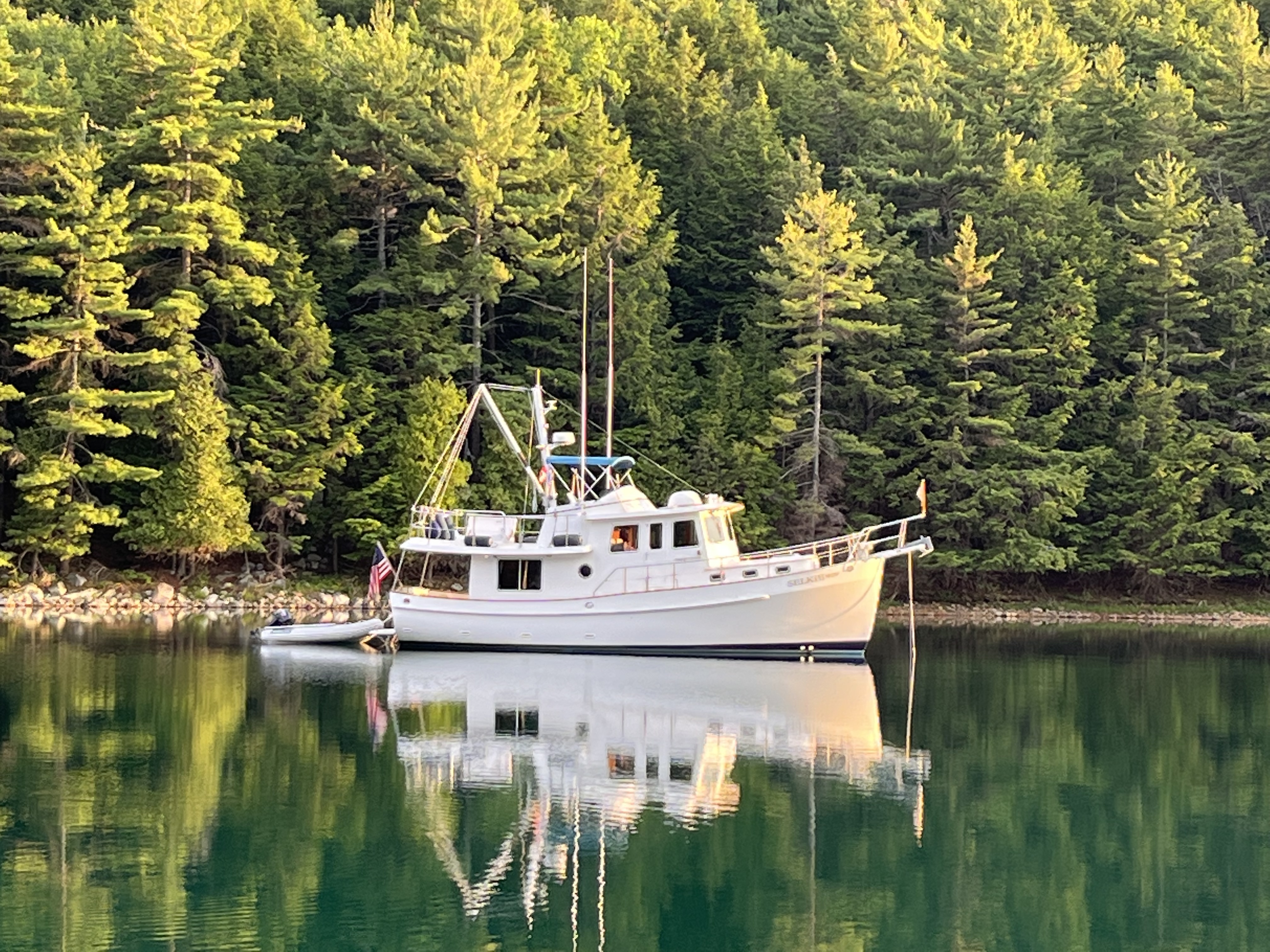In my last post, I mentioned some rough weather that was going to be coming on the Great Lakes.

All the flotillas except a few boats were hanging in the Hammond, Indiana Marina just across the border from Illinois waiting to go down the Calumet River.
The weather reports indicated precipitation and gale force north east winds for the weekend.
The Calumet River entrance is protected by a breakwater, but the Hammond Marina is not, except for a breakwater immediately surrounding the docks.
Anything blowing from the north east across Lake Michigan causes rough conditions in that marina, and makes entering and exiting that marina difficult, if not dangerous.
That’s why we chose not to stay there given the weather condition.

Kim, the Director of the AGLCA, called a meeting the Friday before the weather was due with three flotilla leaders including myself to talk about the incoming weather.
We agreed amongst the leaders that we would delay our flotillas three days so that the flotillas ahead of us would not be forced out of safe harbor into a bad situation. The flotilla leader scheduled to leave on that Saturday was very relieved.
However, this meant that instead of leaving on our original schedule date of Monday, we would leave Thursday to go to Joliet.
A lot of the loopers are getting very antsy about getting down the river system.
Many of them have made commitments, including a AGLCA event down in Alabama. This put pressure on everyone to move instead of relax.
I also think many are getting a little tired of the cool fall weather while living on a boat.

(photo by Libbie)
Regardless, I reached out to my flotilla to let them know the bad news. Everyone took it in stride as no one likes to go in really bad weather.
One of my flotilla members responded back and asked if he could go ahead and leave early on Monday, our original travel date. No one was traveling then, so it would not have been a problem
He was a general manager of a marina an hour north of Boston, and his boat was straight out of the TV Reality Series, Wicked Tuna. He could handle a lot of bad stuff.
The weather really wasn’t a problem for us with Selkie because we had already positioned her off the lake at Marine Services on the Calumet River.
We done this intentionally knowing that the weather was going to be bad and knowing that we could leave any time and not worry about the weather.
Ultimately, I made arrangements to turn over lead responsibilities to another member of our flotilla to lead, so we could go Monday.
I cleared all of this with Kim our Director. She was happy to hear it because the more boats we could get down the river, the more room there is for everybody coming behind us.
Over that weekend, the weather turned very sour.
This was the bouy reading off Winthrop Harbor on Saturday where we had kept Selkie while traveling to Tahoe and Austin:

We moved back onto Selkie on Sunday night and prepped her to depart early Monday morning.
We also lowered our radar mast and our bimini top covering Selkie’s flybridge so that we could clear 14+ feet under bridges.
When we woke up on Monday morning, the Chicago buoy in Lake Michigan was showing 2 1/2 foot seas at about five seconds, but the Michigan City, Indiana buoy was showing 5.3 feet at six seconds. That’s very rough.
Regardless a couple of boats decided to leave Hammond Indiana. They made it safely to the Calumet, although one complained that he spilled his coffee in the rough water on the way to the Calumet River entrance.
We left Marine Services with a little mist in the air, but the weather continued to improve.
Coming down the Calumet River it’s a lot prettier than we expected.

There is a lot of trees that are starting to change color.
There are a lot of other interesting things as well on the upper Calumet like traffic on highways, trains, power plants, power lines, bulk freight yards with piles of coal, stone, mulch, as well as steel mills, old marinas and old sunken pleasure boats.
The Calumet River is dredged to about 15 feet deep which was plenty in terms of depth.
We had one lock to get through at Lockport, which was uneventful.
We also went through the Fish Barrier built to keep the Asian Carp out of the Great Lakes.

It must be working, as we noted that there was a lot of egrets, herons and other fish eaters, including an immature bald eagle hanging out by the fish barrier.

It was interesting that the birds knew that there was a steady supply of freshly shocked fish in the water.
Obviously it is called a fish barrier and not a bird barrier as it doesn’t affect the birds as much as the fish.
Locking through the Lockport Lock, we tested out our new locking loop! This came from another looper.

The Illinois State Police Firing Range was next to the lock in full roar, and it sounded like a war zone as we locked through.
We spent the night in Joliet, which has a reputation of being a bit of a rough town.
There have been problems on the Joliet free wall where we tied up in the past, but there was a pretty strong police presence therein the area for our stay and we felt very safe.
Back in the early 1980s, I worked on an Outage at the Commonwealth Edison Joliet power plant on the night shift.

While working there, I came to know some of folks that live in Joliet. They are definitely from a different background than I was from but I found them all to be friendly then and we found people there to be friendly now.
I think it’s just how you approach people. If you approach folks with fear or suspicion, they respond in kind. If you approach folks with kindness, they respond in kind. And if they don’t in that latter case, they aren’t worth your time.
A couple of towboats pushing their fleet of barges passed us during the night which caused the bridges to open.


The next morning I called the Brandon Lock operator and asked if we could go through. They said to come on up and plan the lock-through at 6:45.
It was pea soup fog.
When we arrived, we called into the lock master.
They said the the lock was closed because of the fog.
We held station for quite a while until the fog cleared.
While we held station (it took 2 hours for the fog to burn off), Lib made cookies and passed them to the lock master. They were appreciative as was the crew that rafted to us.
There was an interesting sign at the entrance of a lock going the other way. The sign said that all boats were required to remove fish that jumped on board their boat before exiting the lock.
This must reference the Asian carp infestation.

We continued on our locking expedition for the day.
We had two more lots to go to before we got to our end game at Heritage Harbor.
The Dresden lock was uneventful.
We passed a large 3×5 (3 barges wide by 5 barges long) tow going in our direction about 5 miles from the Marseilles Lock (pronounced Mar-sells because this is the Midwest)
We hoped that the Marseilles Lock would lock us through first before any tows.
Commercial Traffic has priority over pleasure craft.
We arrived at Marseilles Lock to find a split tow in the lock chamber. Fortunately, the tow was almost fully locked through.
We waited a half hour and were allowed in with another single barge tow that had been waiting. We locked through and headed to our marina for the evening, arriving around 5pm.
It has been a long day, but once docked at Heritage Harbor, the dock master gave us a briefing of the next 500 miles of our trip. That took 2 hours with all the information he gave us, which was very valuable.

After a long day through three locks on the river, plus a 2 hour briefing we were exhausted.
We made dinner and went to bed.
It was going to be a long day the next day.
But we had made it through a more difficult day than we’d had in a while, and we slept well.

3 replies on “First Days on the Rivers”
Glad you have that portion of the journey as a successful memory. Your blog was a suspenseful entertaining read for my peaceful morning. Thanks for sharing it!
LikeLike
Thanks for sharing Tad. I love hearing the updates!
Stay safe!
Al & Karen
LikeLike
Just great reading!! Thanks for taking us all along on your journey – super interesting!
LikeLike